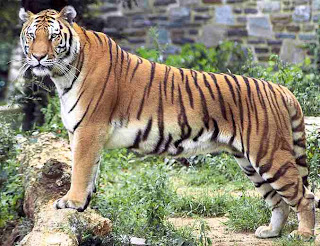Bengal Tiger | The Bengal tiger is the national animal of Bangladesh and is considered to be the second largest tiger in the world. The Bengal tiger (also known as the Royal Bengal tiger) is a subspecies of tiger, found across the Indian subcontinent. The Bengal tiger is the most numerous species of tiger in Asia and is found in dense forests and mangrove swamps and jungles throughout India, Bangladesh, Bhutan and Nepal, although the Bengal tiger's range today is much smaller than it once was.
The Bengal tiger is considered to be the second largest species of tiger, although recent reports suggest that the Bengal tiger is on average, larger than the Siberian tiger. The Bengal tiger has a yellow or light orange coat, with black or dark brown stripes and a white belly. The white tiger is a Bengal tiger that has mutated genes, meaning that it is white in colour with black stripes. Black tigers are known to have black fur with lighter coloured stripes but are even rarer than the white tiger.
The Bengal tiger is a dominant and carnivorous predator, hunting its prey by stalking it until the Bengal tiger has the opportunity to catch it off guard. Bengal tigers primarily hunt larger mammals including deer, wild boar, cattle and goats. Due to the size and power of the Bengal tiger, it has no natural predators in its native environment. Humans that hunt the Bengal tiger and habitat loss are the only threats to the Bengal tiger.
After a gestation period of 3 to 4 months, the female Bengal tiger gives birth to up to 5 cubs. Newborn Bengal tiger cubs weigh about 1 kg (2 lb) and are blind and helpless. The mother feeds them milk for about 2 months and then the Bengal tiger cubs are introduced to meat. Bengal tiger cubs depend on their mother for the first 18 months and then they start hunting on their own.
Today, due to habitat loss caused by deforestation, and hunting by human poachers, the Bengal tiger is considered to be an endangered species. Despite being the most common of all the tiger species, there are thought to be around 2,000 Bengal tigers left in the wild.






No comments:
Post a Comment